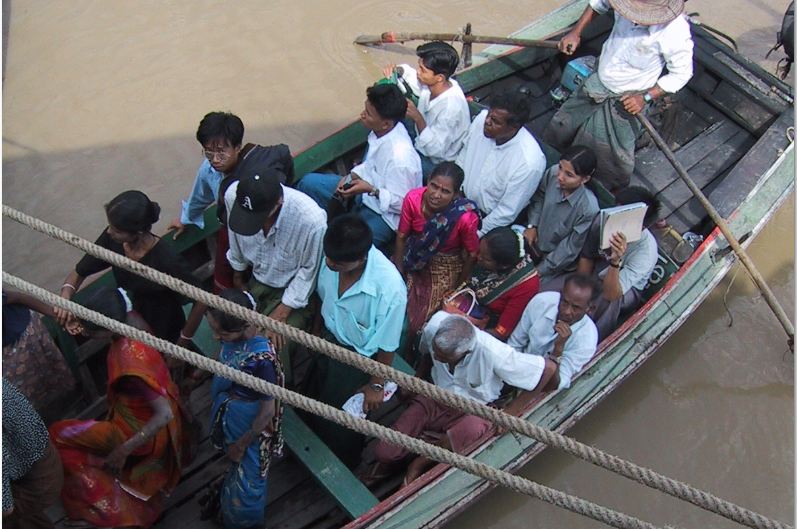In the late 1950s, two Americans with a keen interest in political dynamics in Southeast Asia published a best-selling novel set in a fictitious country called “Sarkhan”–“a small country out toward Burma and Thailand”, as the monolingual political hack owed a favour by his party whom Washington sends out as its ambassador is told when he is offered the post.* William Lederer and Eugene Burdick used Sarkhan as a generic Mainland Southeast Asian country of the high Cold War, a land with graceful people and an ancient culture, a predominantly rural society with a sophisticated elite over whose fate the West and the Soviet Bloc were locked in a brutal contest. Was Sarkhan really Laos, Thailand, Burma, Cambodia? It had traces of all four. It was meant, as noted, to be generic.
Few observers have considered Myanmar generic for a long time. By the time of the fall of Saigon, its xenophobic “Burmese path to socialism” had already led many to view it as a quaint Southeast Asian outlier. After the 1988-1990 period–which brought terrible blood-shed on the streets of Yangon, the rise of Aung San Suu Kyi, the abrogation of her party’s election victory, the introduction of naked military rule, international pariah status and deep economic decline, and a long, long wait for a break that many thought would not come in their life-times–Myanmar’s particularities appeared even more striking. Neither have the events of the past year and a half made it seem any less generic, above all in the eyes of those who would now hail it as “the last economic frontier in Asia” and join what the editor of a leading Yangon weekly recently called the current “Myanmar rush”.
Such views were always deeply silly. Thankfully, the marked change inYangon’s climate relative to six and even three months ago has now made them demonstrably silly. This change is encouraging. Facts on the ground are becoming clearer. The realities that will defineMyanmar’s political economy in the medium-term future seem to be coming into focus. For foreign firms and governments and international organizations that take Southeast Asia seriously, whose understanding of the region transcends the level that one associates with, say, the leadership of American chambers of commerce in Southeast Asian capitals or the pampered, parochial globalists-in-their-own-minds who staff the International Monetary Fund and the International Bank for Reconstruction and Development, this is good news.
As the irrational exuberance of the past year ebbs, Myanmar is not becoming Sarkhan. The high Cold War inSoutheast Asia is long over. But the country is beginning to present what look like familiar, even generic, contours of post-Cold War Southeast Asian political economies. It is worth tracing some eight of these contours.
1. Agriculture dominates employment in Myanmar, with 70 percent of the population employed in the sector. It accounts for just over 40 percent of GDP. It is the largest sector of the economy, but one whose productivity lags that of other sectors. Many Myanmar people on the land face deep, deep poverty. Food is often an issue; nutrition is almost always an issue. Linkages between the Myanmar farm sector and other sectors merit close attention. Few observers will believe–pace John Mellor and his student Lee Teng-hui–that agricultural surplus is destined to fuel industrial growth in the second decade of the twenty-first century, in Myanmar or elsewhere. But unless Myanmar can, to borrow an expression from the late Arthur T. Mosher, get its agriculture moving, its people’s lives will remain difficult and its consumers’ purchasing power low. There will in all likelihood be political consequences, not least as manifest in elections.
2. Myanmar faces a resource curse. Inflows of money to buy Myanmar’s primary products from the limited number of countries doing business with the country had already driven the exchange rate up and distorted the national economy, even before the waiver and suspension of sanctions began. With the country now open to many other business partners, this effect may well be exacerbated. The development of a foreign-owned plantation sector could worsen this curse. Any investor lusting afterMyanmar’s natural resources is a potential agent for further worsening still. Myanmar may not escape its resource curse and the ensuing risk of long-term economic distortion any time soon.
3. As it marks all of Southeast Asia, urban primacy marks Myanmar. Yangon and Mandalay dwarf other towns. The first is home to at least seven, eight, or nine percent of the country’s population, but to far higher percentages of its doctors, good schools, newspapers, and more. Pronounced urban bias is already evident in Myanmar’s economic policy regime. The continued overvaluation of the exchange rate hurts producers but benefits urban consumers. While Myanmar needs capital goods, some observers point to an extended luxury import boom. Observant businessmen from Asia visiting Myanmar for the first time have a hard time squaring the signs of prosperity that they see in Yangon with the country’s amply documented poverty. All of this is typical of the region, a region of primate cities. Urban primacy brings benefits: it concentrates economic activity and thus creates certain efficiencies. For the foreseeable future, serious industrialization in Myanmar will be centred onYangon. But urban primacy also brings disadvantages: the atrophy of and fiscal starvation of sub-national government as well as urban congestion, slums, pollution, and eventual diseconomies of scale.
4. A complex dynamic among technocrats and soldiers and domestic business interests also numbers among the contours of Myanamar’s emerging political economy. The country’s ascendant technocrats have articulated a commitment to economic growth through the creation of a competitive setting for foreign direct investment. They have sold many of the former soldiers now in power on this model. They have sought to broaden the base of the country’s technocracy by creating a new National Economic and Social Affairs Council to serve the executive branch. This council joins parliament’s Commission on the Assessment of Legal Affairs and Special Issues among Myanmar’s brain-trusts. But these bodies serve as an arena–an arena that those familiar with, say, the Thai and Indonesian stories will recognize–for a continuing dance among technocrats, soldiers or ex-soldiers, and businessmen. One of the leading foreign observers of the Myanmar economy remarked not long ago that Myanmar’s leading businessmen are at one and the same time actively in favour of change, willing passively to go along with it, and nervous about the competition that change will bring. And there is another level to this dynamic. Some big business interests have begun to criticize the technocrats’ commitment to FDI, not necessarily out of concern for their own firms but rather with warnings that smaller Myanmar firms and the social bases of post-socialist urban Myanmar cannot survive what the technocrats plan. These criticisms may well shape the rarely reported politics of economic change in Myanmar, politics that will matter. What is certain is that the remarkable absence of open economic xenophobia characteristic of much of 2011 and early 2012 has given way to a more realistic sense that Myanmar’s domestic business sector needs a seat at the table, that asserting one’s interests does not make one a corrupt, rent-seeking “crony”. This new awareness has been manifest in what is perceived as the possible roll-back of some opportunities for foreign enterprise and in resultant terms governing foreign investment that may hold nothing unfamiliar in the Southeast Asian context. Observers note that this dynamic will play out differently in different sectors. It is not about “booty capitalism”. The commitment to building a real economy remains broad, but the perceived “stalling” in the making of some decisions reflects the dynamic among ex-soldiers, technocrats, and domestic business interests, one as regionally familiar as it is likely to be enduring.
5. Another feature of the landscape is and will remain state-owned enterprises, fully familiar to observers who know today’s Singapore and Vietnam or the Thailand and Indonesia of the recent past well. Several weeks ago, at the Myanmar Forum in Singapore, presidential economic advisor Winston Set Aung said that leading reformer, ministry of industry, and chairman of the Myanmar Investment Commission U Soe Thein was committed to a Myanmar without state-owned enterprises. But he spoke in the same breadth of measures such as “corporatization” and “equitization” that have had such chequered histories in contexts such as Singapore and Vietnam. Will Myanmar’s private-sector firms grow so rapidly as to render irrelevant even unreformed state enterprises, as in Thailand? Will they reduce the current role of the military-owned Myanmar Economic Corporation and Myanmar Economic Holdings to nothing? Will these corporations be dismembered? Will they prosper, as through joint ventures? None of this is clear. But none of it will happen overnight. That much is clear. State-owned enterprises will remain a feature ofMyanmar’s political economy for the foreseeable future.
6. Also in footsteps its neighbours, Myanmar is beginning to grope toward industrial and investment policies. Viewers may not see Myanmar versions of the “Remarkable Indonesia” commercial of the Badan Koordinasi Penanaman Modal RepublikIndonesia on BBC World television any time soon. But the effect is the same. Myanmar will promulgate a revised special economic zone law and a foreign investment law. But will these laws help more than on the margins? Reference to other large Southeast Asian economies may be instructive here.
7. Much the same is true of the role of the international financial institutions. One may well see crucial interventions in specific policy areas, as has occasionally been the case elsewhere in Southeast Asia. But the IBRD, IMF, and ADB are not going to wave magic wands and create a modern Myanmar economy. Rather, they will become more and more taken-for-granted parts of the scenery. How many in today’s Saigon hang on the words of these outfits’ expatriate economists sitting in Hanoi? Would Thailand notice if the IBRD mission in the Siam Discovery tower were vaporized tonight?
8. Finally, many in this post-Asian Financial Crisis world may find it curious or outright unbelievable, but Myanmar will have a domestic–and domestically controlled–banking sector. Bank credit today amounts to only five percent of GDP. Yet there are some 20 non-government commercial banks. Yes, there will be banking and foreign exchange laws. Yes, the Myanmar Central Bank will up its game, not least through cooperation with foreign institutions. More branches of fewer banks will, ideally, help finance growth in the countryside and then mobilize resultant savings. But knowledgeable observers do not consider large domestic firms under-capitalized. These firms are hardly waiting for foreign banks to enter Myanmar and ride to their rescue. Trade finance defines the activities of much of Myanmar’s financial sector, broadly understood, just as it long did inThailand. Foreign involvement, on some terms, will become part of the financial landscape. But the hedge-fund gang needs to take a cold shower and, upon emerging, look “financial sovereignty” up on the Web.
Along with these eight rather generic features of post-Cold War SEA which characterize Myanmar’s emerging political economy, the country does show a few distinctive wrinkles. One is the significant role of parliament vis-├а-vis the executive branch in deliberations over economic policy. A second is the possibility that a competitive election in 2015 will change the cast of characters making economic policy before this emerging political economy is fully consolidated. A third is the relatively poor preparation and thinness of the Myanmar technocracy, a weakness due not least to a failure to offer young Myanmars the right sort of educational and training opportunities in recent decades on the part of Japan, the United States, Australia, and Europe. Myanmar thus presents a real contrast to post-1958 Thailand, to Indonesia in the early New Order, and even perhaps to Vietnam as the results of “đổi mới” began to attain critical mass. Fourth, of course, is Myanmar’s relationship with its largest neighbour. To amend the long-time Mexican president Porfirio D├нaz’s probably apocryphal lament, the country is so far from God and so close, so very close, to the People’s Republic of China!
What are the implications of this quick tracing of the contours of Myanmar’s emerging political economy? The most surprising implication is how familiar it all looks. But, please note, this familiarity is not due to Myanmar’s being destined to follow the path that its neighbours inSoutheast Asia have already followed. This is not the story of a laggard. It is not even the description of a path. Rather, it is the characterization of a not so unfamiliar political-economic environment, one likely in most of its features to endure, and one to which those who would understand and maybe even take a hand in Myanmar’s future ought to accustom themselves.
__________________
*William J. Lederer and Eugene Burdick, The Ugly American (New York: W. W. Norton & Co., 1958).
 Facebook
Facebook  Twitter
Twitter  Soundcloud
Soundcloud  Youtube
Youtube  Rss
Rss 